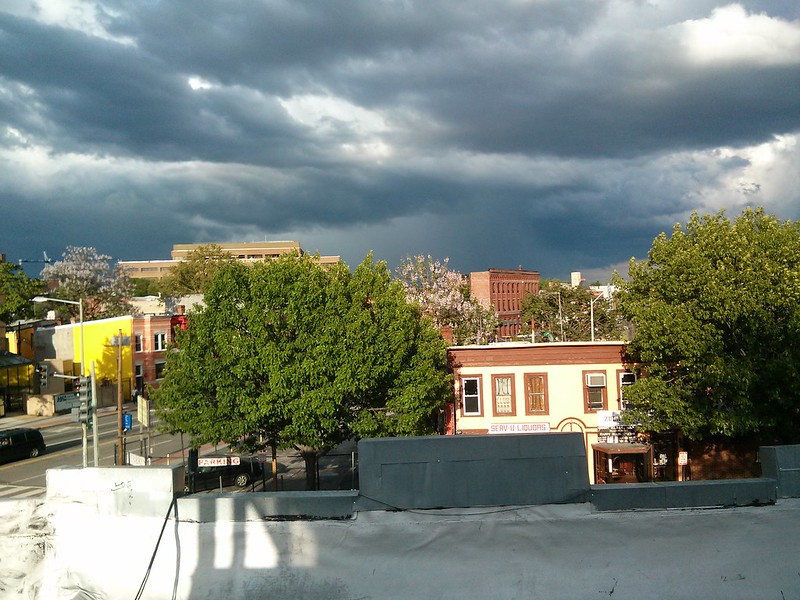After two trips there this year I have some thoughts...
There seems to be a lot of development around Metro stations. I know there's a height limit but even within that, you see brand new buildings that are 10 stories tall easily. A lot of the newer blocks seem quiet, or not filled out yet, for whatever reason. Too new, maybe.
There's also a lot going on around suburban Metro stations. I visited Rosslyn (Arlington), Alexandria, Reston, Bethesda and Rockville. Saw the new Silver Line extension under construction (and a test train running).
There's something strange about the new developments out there though. They don't seem to be contributing to street life. Maybe I'm not being fair; I did see some going up that look like they could produce a good ground floor activity level. But there's a pattern of development which I find really strange, although my friend is accustomed to it because he lives in it: isolated residential towers.
For example, he lives an 8 minute walk away from a Metro station, but that walk is across a nasty 4 lane road, and a bunch of parking lots. There's nothing around him except for greenspace and parking lots. It's a high-rise tower in a small ravine on the corner of a golf course (I think?) with a massive parking pedestal. 30 minute walk to a grocery store, he told me, and the main drag is one of those infamous American 8-lane stroads. But hey, there's a Metro station, so the rents are higher than what I pay in Boston.
My cousins live in a luxury condo in Reston, where there's a lot of high-rise construction going on. Again, the streetwall is largely blank or pocked by parking garage entrances. The station isn't built yet but there's a bus depot instead. And the "streets" are very wide. I didn't see anyone else walking there.
I find this pattern of development puzzling because the main reason for height is lack of land. But there's no lack of land in these locations. My friend tells me the land is very valuable there for other reasons, so maybe that's it. And maybe these highrises could be integrated into a more urban neighborhood in the future when it's more built out. But I don't see it happening with those giant stroads and parking garages everywhere.
I'd be curious if anyone else has experience there and comments on this. I feel like D.C. has some very beautiful, classic urban neighborhoods, and the new development is not living up to those standards, and may cause a backlash in the end.
There seems to be a lot of development around Metro stations. I know there's a height limit but even within that, you see brand new buildings that are 10 stories tall easily. A lot of the newer blocks seem quiet, or not filled out yet, for whatever reason. Too new, maybe.
There's also a lot going on around suburban Metro stations. I visited Rosslyn (Arlington), Alexandria, Reston, Bethesda and Rockville. Saw the new Silver Line extension under construction (and a test train running).
There's something strange about the new developments out there though. They don't seem to be contributing to street life. Maybe I'm not being fair; I did see some going up that look like they could produce a good ground floor activity level. But there's a pattern of development which I find really strange, although my friend is accustomed to it because he lives in it: isolated residential towers.
For example, he lives an 8 minute walk away from a Metro station, but that walk is across a nasty 4 lane road, and a bunch of parking lots. There's nothing around him except for greenspace and parking lots. It's a high-rise tower in a small ravine on the corner of a golf course (I think?) with a massive parking pedestal. 30 minute walk to a grocery store, he told me, and the main drag is one of those infamous American 8-lane stroads. But hey, there's a Metro station, so the rents are higher than what I pay in Boston.
My cousins live in a luxury condo in Reston, where there's a lot of high-rise construction going on. Again, the streetwall is largely blank or pocked by parking garage entrances. The station isn't built yet but there's a bus depot instead. And the "streets" are very wide. I didn't see anyone else walking there.
I find this pattern of development puzzling because the main reason for height is lack of land. But there's no lack of land in these locations. My friend tells me the land is very valuable there for other reasons, so maybe that's it. And maybe these highrises could be integrated into a more urban neighborhood in the future when it's more built out. But I don't see it happening with those giant stroads and parking garages everywhere.
I'd be curious if anyone else has experience there and comments on this. I feel like D.C. has some very beautiful, classic urban neighborhoods, and the new development is not living up to those standards, and may cause a backlash in the end.


